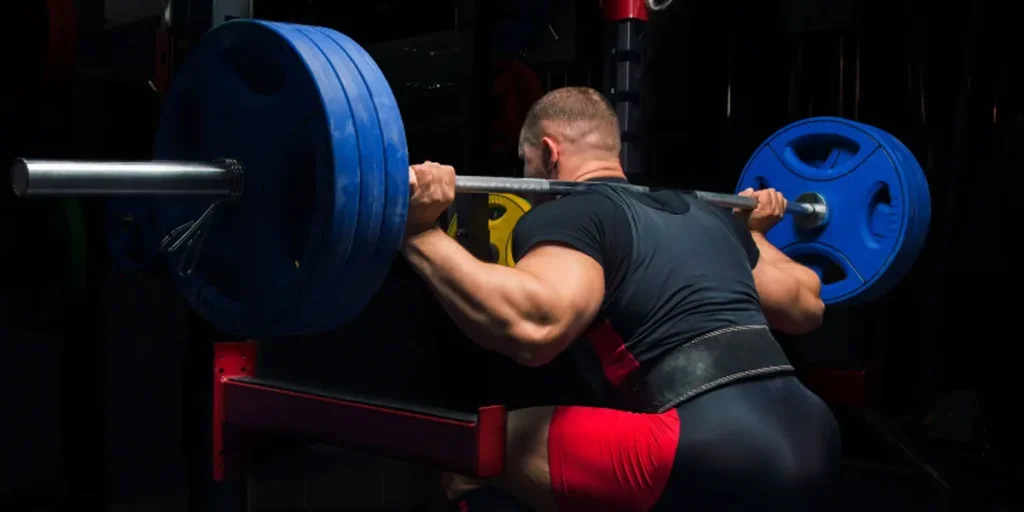A standard squat bar weighs about 45 pounds (20 kilograms). Olympic squat bars may be heavier, at around 55 pounds (25 kilograms).
Many fitness enthusiasts and athletes use squat bars during their training routines to enhance strength and muscle development.
Squat bars, also known as barbells, are essential pieces of equipment in weightlifting, powerlifting, and bodybuilding.
Their weight contributes to the resistance required for effective training, making squats a powerful exercise for lower body strength.
Understanding the weight of a squat bar is crucial for tracking the progress and setting accurate lifting goals during workouts.
It ensures that individuals can manage their lifting capacity safely, preventing injuries and maximizing the benefits of their exercise programs.
With correct technique and incremental weight increase, squatting with a barbell can be an integral part of achieving superior strength and physical fitness.

Weight Standards For Squat Bars
When you step into the gym to conquer the squat rack, knowing your equipment is vital. One key factor is the weight of your squat bar.
Different bars have different standards. It’s not just about lifting; it’s about lifting correctly and safely.
A Look At International Specifications
International standards set the bar high—literally. Olympic squat bars must follow strict guidelines.
- Weight: Approximately 20 kilograms or 44 pounds
- Length: Around 2.2 meters or 7.2 feet
- Diameter: 28 millimeters
These specs ensure uniformity in competition. Quality materials guarantee the bar can handle heavy weights.
Comparing Men’s And Women’s Bars
Men’s and women’s bars differ for optimal use. Let’s dive into how they vary.
| Feature | Men’s Bar | Women’s Bar |
|---|---|---|
| Weight | 20kg (44lbs) | 15kg (33lbs) |
| Length | 2.2m (7.2ft) | 2.01m (6.6ft) |
| Diameter | 28mm | 25mm |
The lighter weight and smaller diameter of women’s bars accommodate different body types and grips. Both bars are crafted for peak performance and safety.
Types Of Squat Bars And Their Weights

Choosing the right squat bar can make a big difference in your workout. Different bars have different weights, which can change how you perform squats.
Let’s explore the most common types of squat bars and how heavy they are.
Olympic Vs. Powerlifting Bars
Olympic bars and powerlifting bars are designed for different kinds of strength sports. Each one has a distinct weight.
| Type of Bar | Weight |
|---|---|
| Olympic Bar | 20 kilograms (44 pounds) |
| Powerlifting Bar | 20 kilograms (44 pounds) |
Olympic bars are meant for dynamic lifts like snatches. They often have more whip or bend and rotating sleeves.
Powerlifting bars are stiffer, making them better for heavy squats with little bend.
Specialty Squat Bars
Specialty squat bars are designed to improve your squat technique or to reduce injury risk.
- Safety Squat Bar – Typically around 32 pounds (14.5 kilograms). This bar has padded shoulder supports and encourages an upright posture.
- Cambered Squat Bar – Usually weighs 65 pounds (29.5 kilograms). The bar has a unique shape that allows more movement.
- Hex Bar – Also used for deadlifts, weighs around 45-55 pounds (20-25 kilograms). It allows you to stand in the center, reducing stress on your back.
Each specialty bar can have variations though. Always check the specific weight before lifting.
Factors Affecting Squat Bar Weight

When choosing a squat bar, it’s essential to understand what influences its weight. Knowing this can help lifters select the right bar for their needs.
Three main factors can affect the weight of a squat bar. These include the materials used to make the bar, the bar’s length, and its diameter.
Material And Manufacturing Processes
The material of a squat bar plays a crucial role in its weight. Manufacturers often use high-quality steel. This ensures the bar can handle heavy weights.
The type of steel and the process used to make the bar can also add weight. There are two common types of manufacturing:
- Standard: Uses regular steel and may result in a lighter bar.
- Olympic: Often employs stronger steel, adding to the bar’s heaviness.
Bars also go through various treatments. These treatments can affect weight. For example, a bar with a coating for rust resistance might be heavier.
Bar Length And Diameter
The dimensions of a squat bar determine its weight as well. Standard bars and Olympic bars differ in length, which affects their overall mass.
| Bar Type | Length | Diameter | Weight |
|---|---|---|---|
| Standard Bar | 5-6 feet | 25-28 mm | 15-19 pounds |
| Olympic Bar | 7.2 feet | 28-32 mm | 45 pounds (20 kg) |
A longer bar will generally be heavier. The diameter also adds weight. A thicker bar adds more metal, thus increasing the weight. A standard Olympic bar typically weighs around 45 pounds because of these dimensions.
Impact Of Bar Weight On Training
Understanding how much a squat bar weighs is crucial for every type of lifter, whether a beginner or a seasoned athlete.
The bar’s weight can significantly affect one’s training routine. It dictates how much weight an individual can safely and effectively handle during exercises.
Knowing the exact weight of the barbell allows for accurate measurement of progress and helps in setting realistic strength goals.
Calibrating Your Lifting Regimen
Setting up an effective lifting schedule requires knowing the bar’s weight. Most standard squat bars weigh about 45 pounds (20 kilograms).
Some specialty bars may be lighter or heavier, depending on their design and purpose. Let’s break down the importance:
- Tracking Progress: When the bar weight is known, lifters can track improvements precisely.
- Adjusted Weights: Lifters can adjust the plates they add, ensuring they lift the intended total weight.
- Consistency: Using bars of the same weight maintains consistency, which is key for accurate measurement.
By embedding the bar weight into your training regime, you set the stage for measurable improvement and minimized injury risk.
Role Of Bar Weight In Performance
The heft of the squat bar plays a pivotal role in how lifters perform. A balance between the lifter’s strength and the bar’s weight optimizes workouts. Consider these points:
- Proper Form: Lifting the right weight helps in maintaining form, which is crucial for effective training.
- Specific Training: Powerlifters and Olympic lifters may choose different bar weights to suit their style of lifting.
- Psychological Edge: Knowing you are lifting with the correct bar weight can boost confidence during a workout.
Overall, the weight of the squat bar must harmonize with the lifter’s capacity to achieve the best performance outcomes.
It directly affects the quality of the squat, the risk of injury, and the trajectory of strength development.
Proper Technique And Safety Considerations
When performing squats, two critical things to consider are proper technique and safety considerations.
Proper handling of a squat bar, which usually weighs about 45 pounds, is vital.
Understanding the correct balance and injury prevention measures ensures safety and effectiveness during your workout routine.
Balancing The Bar Correctly
Finding the right balance on the squat bar is essential for a successful lift. Place the bar on the traps for high-bar squats or on the deltoids for low-bar squats. Here are steps for balancing the bar:
- Stand under the bar with feet shoulder-width apart.
- Position the bar on your chosen rest area.
- Grip the bar evenly with both hands.
- Unrack the bar by straightening your legs.
- Step back and set your stance.
Keep your core tight and a neutral spine to maintain the bar’s balance throughout the movement. The bar should stay over your mid-foot for stability.
Avoiding Injury While Squatting
Preventing injury is just as important as lifting the weight. Follow these guidelines to stay safe:
- Warm-up adequately before lifting heavy weights.
- Maintain form by keeping your knees in line with your toes.
- Engage your hips and glutes as you lift and lower the bar.
- Breath properly to support your core.
- Use safety equipment, like a squat rack with safety arms.
- Have a spotter when attempting heavy lifts.
Start with a lighter weight to master the technique before progressing. Stop the exercise if you feel any pain.
Myths And Misconceptions About Squat Bar Weight
The weight of a squat bar often sparks debate among gym enthusiasts. Several myths surround its actual weight. In this section, we’ll clarify these misconceptions.
Debunking Common Myths
Understanding the true weight of squat bars is crucial for accurate lift records. The standard squat bar does not weigh the same as a typical barbell.
Often, weightlifters mistakenly believe all barbells weigh 45 pounds (20.4 kg).
- Myth: All squat bars weigh 45 pounds.
- Fact: Squat bars can vary and often weigh more, around 55 pounds (24.9 kg).
Another common misunderstanding is that the weight of the bar is the same no matter its type.
- Myth: All types of bars have the same weight.
- Fact: Different bars are designed for specific lifts and can vary in weight.
Some assume that the weight of the bar is included in the total weight lifted.
- Myth: The squat bar’s weight isn’t added to the lift total.
- Fact: Always include the bar’s weight when calculating the total.
Realistic Expectations For Lifters
Lifters at all levels should set expectations based on correct information.
| Experience Level | Squat Bar Weight |
|---|---|
| Beginner | Start with a lighter bar, around 35 pounds (15.9 kg) |
| Intermediate | Move to a standard bar, usually 45 pounds (20.4 kg) |
| Experienced | Progress to a squat-specific bar, about 55 pounds (24.9 kg) |
Training with bars that suit your level helps improve technique and strength effectively. Note the following:
- Check the bar’s weight engraved on the side or end cap.
- Assume nothing; always verify with gym staff if unsure.
- Track your progress including the correct bar weight.
Frequently Asked Questions Of How Heavy Is A Squat Bar
What Is The Standard Weight Of A Squat Bar?
The standard squat bar typically weighs 20 kilograms (44 pounds). Olympic bars used for squatting are designed to conform to this weight specification for consistency in training and competition.
Can Squat Bars Vary In Weight?
Yes, squat bar weights can vary. While the standard bar weighs 20kg, lighter practice bars and heavier powerlifting bars exist, weighing anywhere from 10kg to 25kg, depending on their design and purpose.
How Much Does An Olympic Squat Bar Weigh?
An Olympic squat bar, adhering to official specifications, weighs 20 kilograms (44 pounds). It is standardized for globally recognized Olympic weightlifting and powerlifting events.
Does Bar Weight Affect Squat Performance?
Bar weight can significantly affect squat performance. Heavier bars increase the challenge and can enhance strength gains. It’s important to factor in the bar’s weight when calculating total lifting load.
Conclusion
Wrapping up, understanding the weight of your squat bar empowers your training precision. Standard bars weigh around 45 pounds, with variations for specific workouts.
As you refine your lifting regimen, remember to account for the bar’s weight. It’s essential for accurate progress tracking and achieving your fitness goals.
Keep lifting and stay informed!
Resources:
https://www.ncbi.nlm.nih.gov/pmc/articles/PMC9987429/
https://www.shape.com/hex-bar-benefits-exercises-7093338
